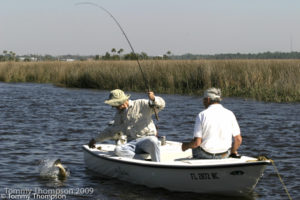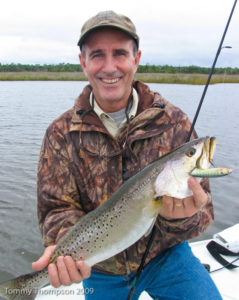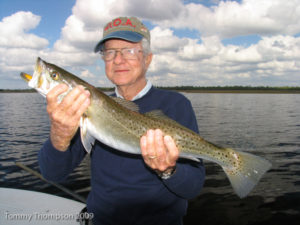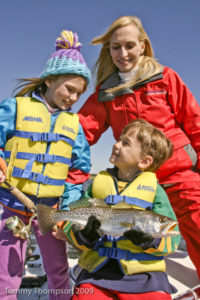Fishing in October? Cooling Waters Heat Up The Big Bend Inshore Bite
I was pleasantly surprised last Sunday when Steinhatchee Capt. Rick Davidson told me he’d been reading water temperatures in the 70s all day. The day was cool and there were pods of bait everywhere, but I didn’t think that the temps had dropped that much in the past few weeks. That’s a good sign, and based on the fact that we found seatrout striking those bait pods was an even better one. The air temperatures are going to stay in the 80s all week, so I’m predicting a good weekend for anglers wanting to fish our Big Bend flats. What cooler air and water mean is that fish, especially trout and redfish, sense the onset of fall and winter and are interested in only one thing—fattening up. Sex isn’t on their little minds right now. It’s all about survival.
Other observations are that the easterly winds and cooler water temperatures have slowed the production and distribution of floating sea grass. There are still some big patches out there, but it’s time for topwater lures again.
The predators, seatrout and redfish) are beginning to feel that winter is coming and are trying their best to fatten up for either spawning or survival (I know some fishermen with the same outlook on life). Bait fish are plentiful as summer ends, and they provide the nutrients needed by reds, trout, grouper and most all marine species. All have fattened up since the last cold spell in March and are now getting ready to pass another winter. Eat, Eat, Eat—that’s what a fish’s life is all about.
If you’re an inshore angler, the best bet this weekend will be to look for jumping mullet or schools of glass minnows moving along the shallow flats. Be careful not to drive the bait to the bottom by running too close to it. Once you spot some bait, maneuver your boat as quietly as you can (troll or pole) so that your drift puts you within casting range. Then, throw plugs, soft plastics, spoons or even live bait to the edges of the bait pod. And, pay attention to whatever structure is there. If there’s a big sand, shell, rock or oyster bar, assume that the predators are going to lay on the up-tide side, out of strong currents, waiting for bait to come to them.
Yankeetown and Waccasassa anglers should give the old bars at the end of the old Waccasassa Channel a try, and those of you at Cedar Key might drift the “Jug Bar,” south of Snake Key. The Suwannee Reefs are a good bet for trout and reds, as the river’s not pumping quite so much water as in the past weeks. Suwannee anglers might also run up towards Horseshoe Cove and join the local gang there. Steinhatchee fishermen, as reported above, are producing great number of reds and trout all the way from Pepperfish Keys to Sponge Point and Hagens Cove, in depths from 1- to 5-feet.





